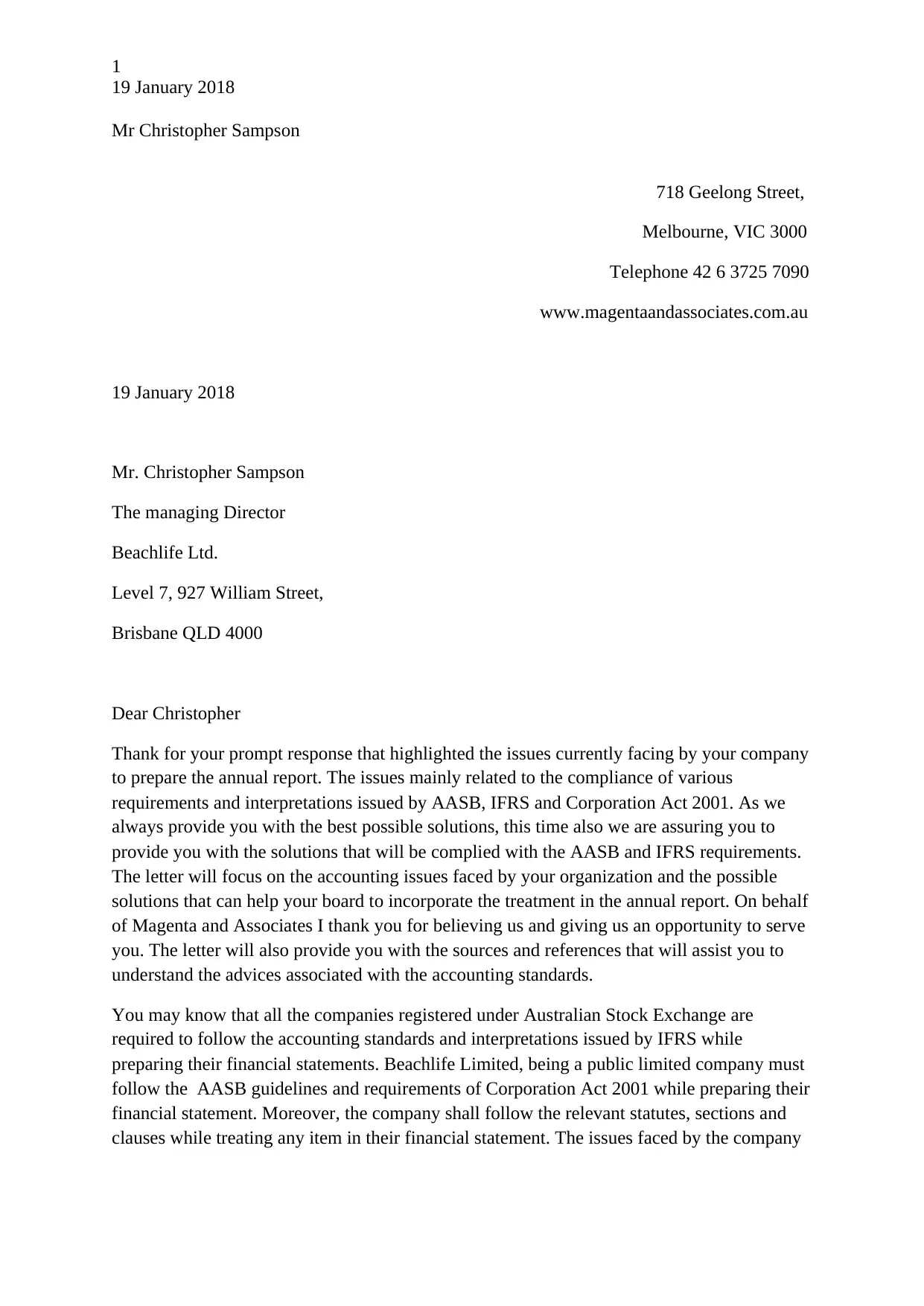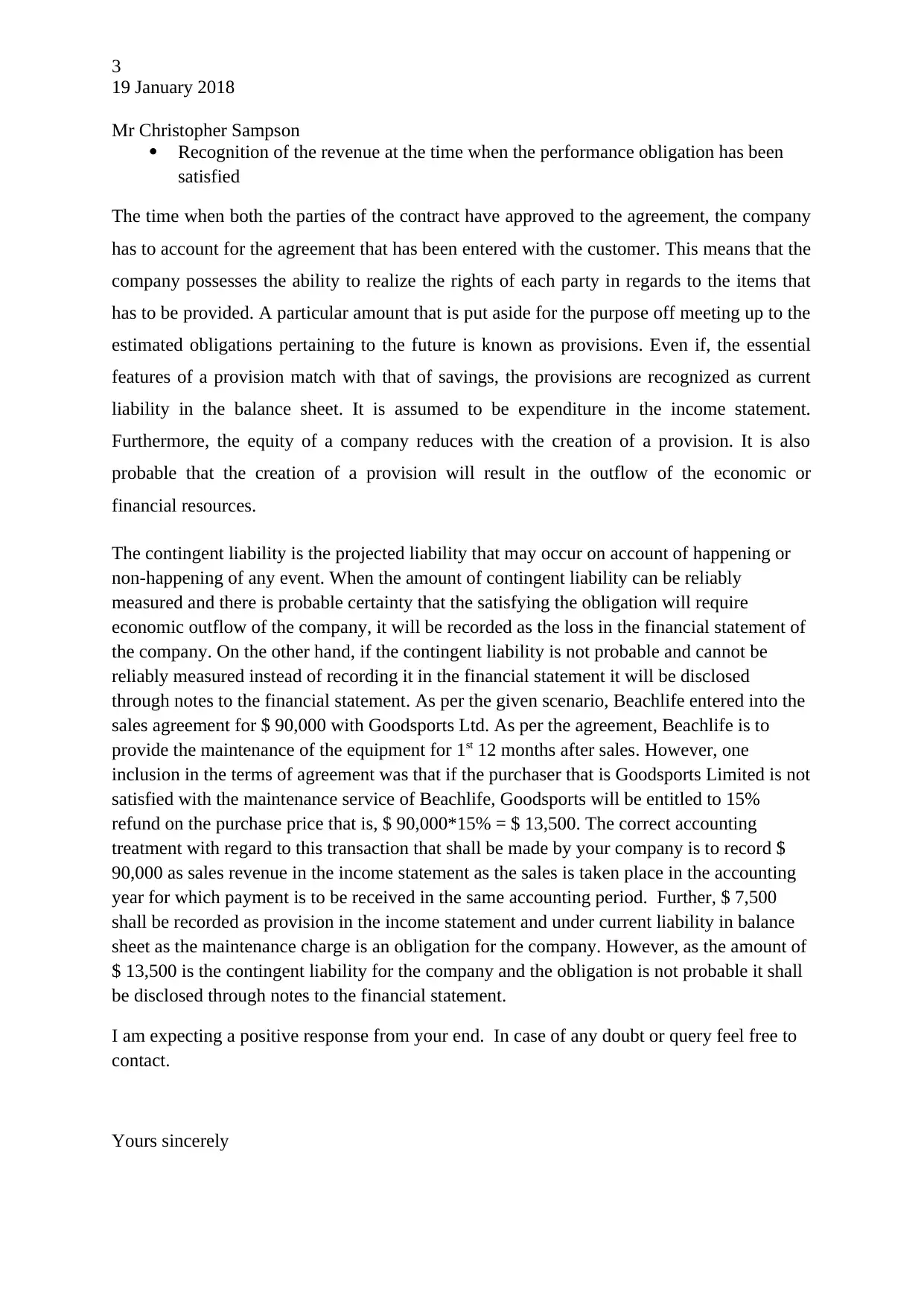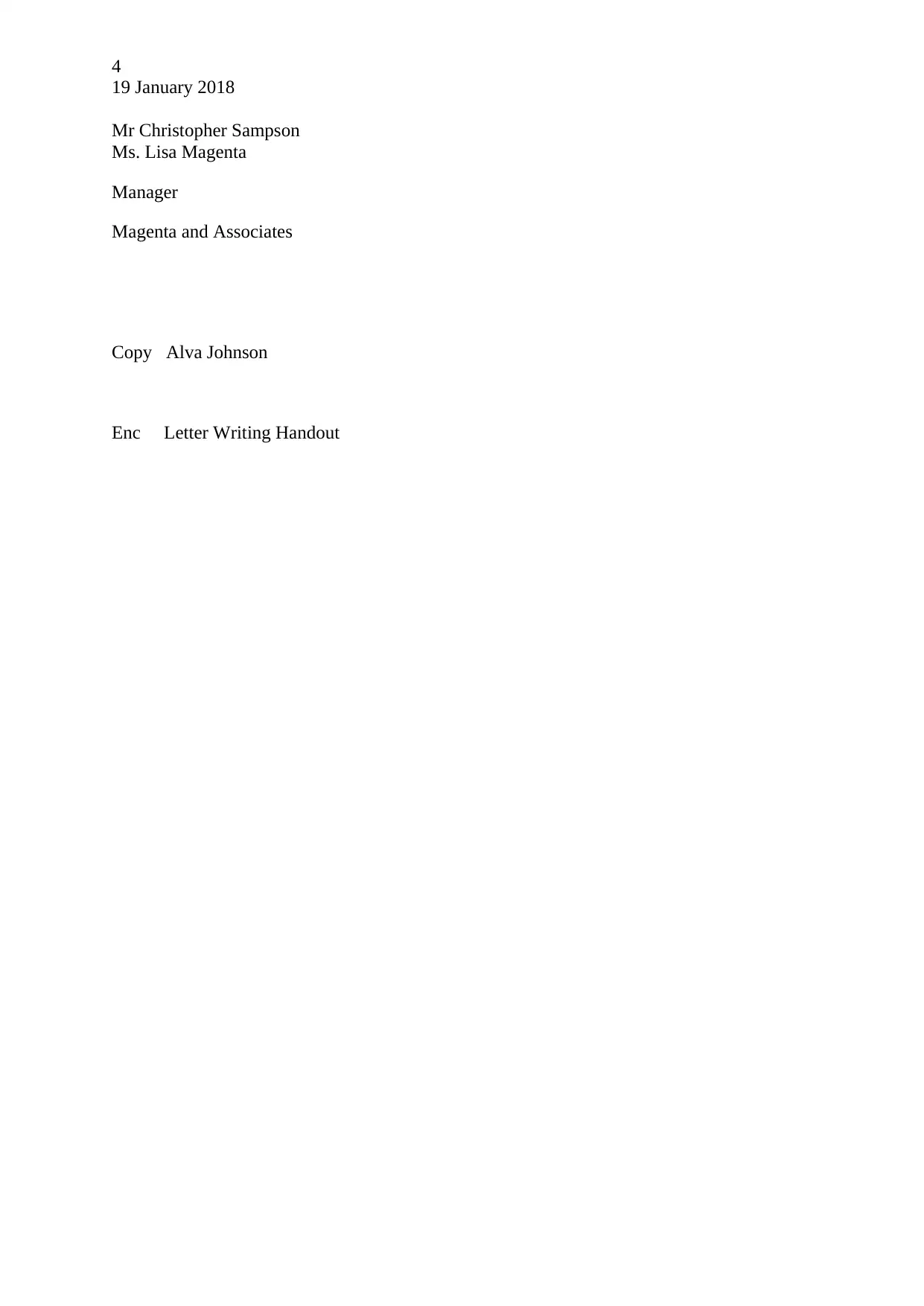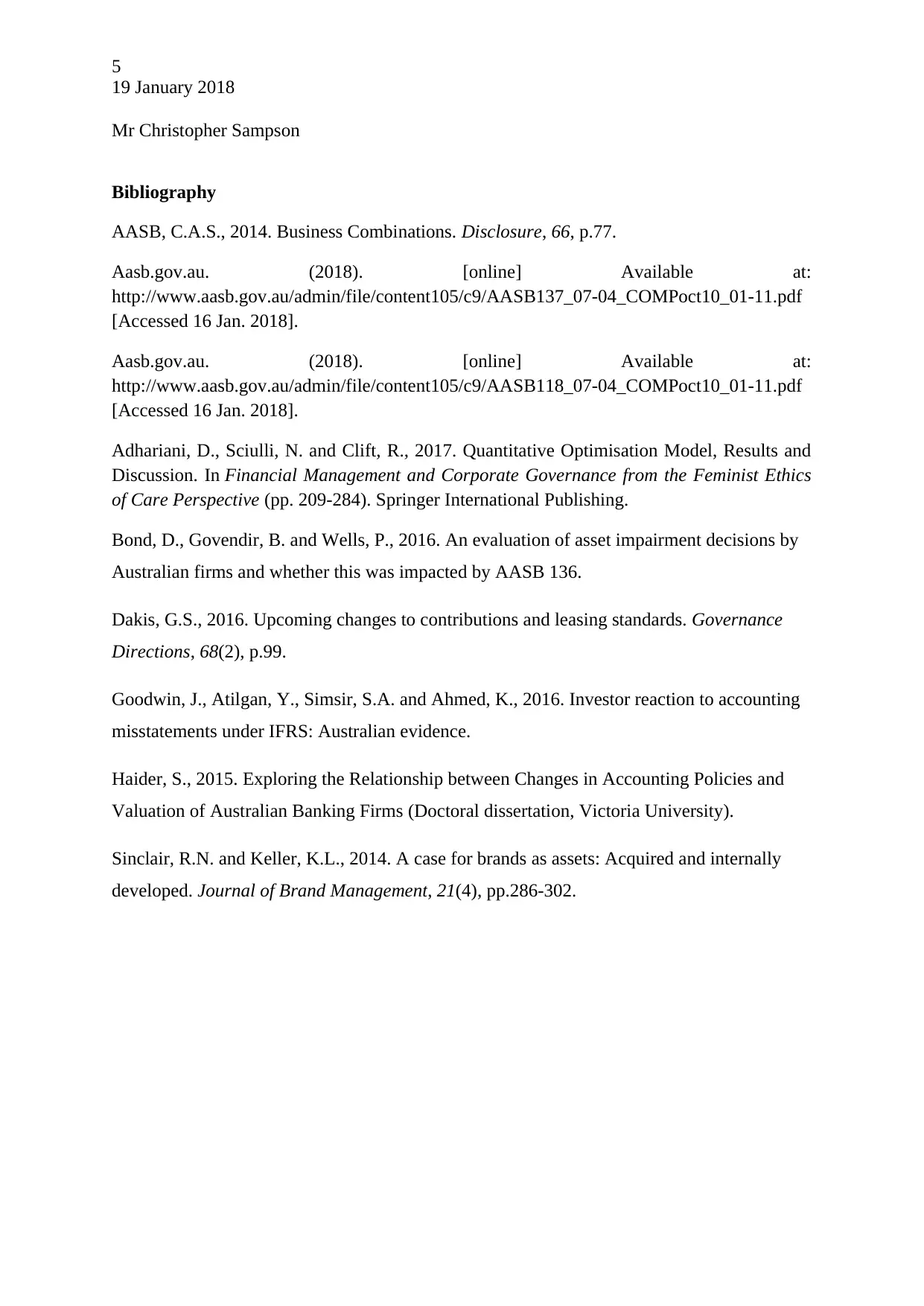Provision for Contingent Liability in Sales Agreements
VerifiedAdded on 2020/05/28
|6
|1563
|48
AI Summary
This document provides a detailed explanation of applying Australian Accounting Standards Board (AASB) standards, particularly focusing on AASB 137 regarding business combinations and asset impairments. It includes a sample letter to assist professionals in understanding how to communicate these accounting treatments effectively. The scenario discussed involves Beachlife Ltd. entering into a sales agreement with Goodsports Ltd., including maintenance obligations and provisions for potential refunds based on satisfaction with services rendered. This document also clarifies the treatment of contingent liabilities under AASB guidelines, offering insights into recording provisions and disclosures in financial statements.

Financial accounting and reporting 1
Name of the student
Name of the university
Author note
Name of the student
Name of the university
Author note
Paraphrase This Document
Need a fresh take? Get an instant paraphrase of this document with our AI Paraphraser

1
19 January 2018
Mr Christopher Sampson
718 Geelong Street,
Melbourne, VIC 3000
Telephone 42 6 3725 7090
www.magentaandassociates.com.au
19 January 2018
Mr. Christopher Sampson
The managing Director
Beachlife Ltd.
Level 7, 927 William Street,
Brisbane QLD 4000
Dear Christopher
Thank for your prompt response that highlighted the issues currently facing by your company
to prepare the annual report. The issues mainly related to the compliance of various
requirements and interpretations issued by AASB, IFRS and Corporation Act 2001. As we
always provide you with the best possible solutions, this time also we are assuring you to
provide you with the solutions that will be complied with the AASB and IFRS requirements.
The letter will focus on the accounting issues faced by your organization and the possible
solutions that can help your board to incorporate the treatment in the annual report. On behalf
of Magenta and Associates I thank you for believing us and giving us an opportunity to serve
you. The letter will also provide you with the sources and references that will assist you to
understand the advices associated with the accounting standards.
You may know that all the companies registered under Australian Stock Exchange are
required to follow the accounting standards and interpretations issued by IFRS while
preparing their financial statements. Beachlife Limited, being a public limited company must
follow the AASB guidelines and requirements of Corporation Act 2001 while preparing their
financial statement. Moreover, the company shall follow the relevant statutes, sections and
clauses while treating any item in their financial statement. The issues faced by the company
19 January 2018
Mr Christopher Sampson
718 Geelong Street,
Melbourne, VIC 3000
Telephone 42 6 3725 7090
www.magentaandassociates.com.au
19 January 2018
Mr. Christopher Sampson
The managing Director
Beachlife Ltd.
Level 7, 927 William Street,
Brisbane QLD 4000
Dear Christopher
Thank for your prompt response that highlighted the issues currently facing by your company
to prepare the annual report. The issues mainly related to the compliance of various
requirements and interpretations issued by AASB, IFRS and Corporation Act 2001. As we
always provide you with the best possible solutions, this time also we are assuring you to
provide you with the solutions that will be complied with the AASB and IFRS requirements.
The letter will focus on the accounting issues faced by your organization and the possible
solutions that can help your board to incorporate the treatment in the annual report. On behalf
of Magenta and Associates I thank you for believing us and giving us an opportunity to serve
you. The letter will also provide you with the sources and references that will assist you to
understand the advices associated with the accounting standards.
You may know that all the companies registered under Australian Stock Exchange are
required to follow the accounting standards and interpretations issued by IFRS while
preparing their financial statements. Beachlife Limited, being a public limited company must
follow the AASB guidelines and requirements of Corporation Act 2001 while preparing their
financial statement. Moreover, the company shall follow the relevant statutes, sections and
clauses while treating any item in their financial statement. The issues faced by the company

2
19 January 2018
Mr Christopher Sampson
at present are related to the treatment of brand recognition and the treatment of contingent
liability.
Suggestions for issue 1 –
Intangible assets are those assets which do not have any physical existence, for instance,
goodwill, patent rights, brand name, license agreements and trademarks. As the intangible
assets do not have any physical substance and are not dealt in the regular active market, the
valuations of these assets are not very easy. Further, the valuation depends on the fact
whether the asset has definite useful life or indefinite useful life. In accordance with Para 63
of IAS 38 and interpretation of IFRS the internally generated assets are not recognised in the
balance sheet of the company under the head of asset. Likewise the brand is considered as the
intangible assets. As the brand helps the customers to recognize the product and generate
their expectations, the valuation of brand cannot be done with any valuation method. Further,
various issues created while measuring and valuing the brand. The value of the intangible
asset like brand cannot be measured exactly until it is sold. Here in the given case, the
directors want to recognize $ 800,000 for the brand ‘Sun n Surf Shirts’, however, at the time
of selling they may get only $ 500,000 or $ 600,000,
As per the accounting standard AASB – 138 on recognition of the intangible asset, if the
asset’s cost is reliably measured and it is quite possible that the future benefit of the asset will
accrue to the company then only it can be recognized. As the brand ‘Sun n Surf Shirts has no
definite useful life and the value cannot be measured reliably until it is sold, it cannot be
recognized as asset under the financial statement.
Suggestions for issue 2 –
We would like you to know that the Financial Accounting Standards Board (FASB) and the
International Accounting Standards Board (IFRS) have led to the issuance of the new
standard in relation to revenue that is IFRS 15. IFRS 15 essentially relates to the revenue
from contracts with the customers that supersede all the requirements pertaining to the
recognition of revenue standards that have been stated by IFRS and GAAP. This particular
standard reflects the principles that a corporate entity has to apply for the purpose of
measuring and recognizing the revenue and the inflows and outflows of cash associated with
it. The sales agreement amount should be recorded by adhering to the IFRS 15 standards.
This should be excited by following the five steps that have been listed down below:
Identification of the contract with the customer
Identification of the performance related obligations of the contract
Determining the effective transaction price
Allocating the transaction price to the performance obligation of the contract
19 January 2018
Mr Christopher Sampson
at present are related to the treatment of brand recognition and the treatment of contingent
liability.
Suggestions for issue 1 –
Intangible assets are those assets which do not have any physical existence, for instance,
goodwill, patent rights, brand name, license agreements and trademarks. As the intangible
assets do not have any physical substance and are not dealt in the regular active market, the
valuations of these assets are not very easy. Further, the valuation depends on the fact
whether the asset has definite useful life or indefinite useful life. In accordance with Para 63
of IAS 38 and interpretation of IFRS the internally generated assets are not recognised in the
balance sheet of the company under the head of asset. Likewise the brand is considered as the
intangible assets. As the brand helps the customers to recognize the product and generate
their expectations, the valuation of brand cannot be done with any valuation method. Further,
various issues created while measuring and valuing the brand. The value of the intangible
asset like brand cannot be measured exactly until it is sold. Here in the given case, the
directors want to recognize $ 800,000 for the brand ‘Sun n Surf Shirts’, however, at the time
of selling they may get only $ 500,000 or $ 600,000,
As per the accounting standard AASB – 138 on recognition of the intangible asset, if the
asset’s cost is reliably measured and it is quite possible that the future benefit of the asset will
accrue to the company then only it can be recognized. As the brand ‘Sun n Surf Shirts has no
definite useful life and the value cannot be measured reliably until it is sold, it cannot be
recognized as asset under the financial statement.
Suggestions for issue 2 –
We would like you to know that the Financial Accounting Standards Board (FASB) and the
International Accounting Standards Board (IFRS) have led to the issuance of the new
standard in relation to revenue that is IFRS 15. IFRS 15 essentially relates to the revenue
from contracts with the customers that supersede all the requirements pertaining to the
recognition of revenue standards that have been stated by IFRS and GAAP. This particular
standard reflects the principles that a corporate entity has to apply for the purpose of
measuring and recognizing the revenue and the inflows and outflows of cash associated with
it. The sales agreement amount should be recorded by adhering to the IFRS 15 standards.
This should be excited by following the five steps that have been listed down below:
Identification of the contract with the customer
Identification of the performance related obligations of the contract
Determining the effective transaction price
Allocating the transaction price to the performance obligation of the contract
⊘ This is a preview!⊘
Do you want full access?
Subscribe today to unlock all pages.

Trusted by 1+ million students worldwide

3
19 January 2018
Mr Christopher Sampson
Recognition of the revenue at the time when the performance obligation has been
satisfied
The time when both the parties of the contract have approved to the agreement, the company
has to account for the agreement that has been entered with the customer. This means that the
company possesses the ability to realize the rights of each party in regards to the items that
has to be provided. A particular amount that is put aside for the purpose off meeting up to the
estimated obligations pertaining to the future is known as provisions. Even if, the essential
features of a provision match with that of savings, the provisions are recognized as current
liability in the balance sheet. It is assumed to be expenditure in the income statement.
Furthermore, the equity of a company reduces with the creation of a provision. It is also
probable that the creation of a provision will result in the outflow of the economic or
financial resources.
The contingent liability is the projected liability that may occur on account of happening or
non-happening of any event. When the amount of contingent liability can be reliably
measured and there is probable certainty that the satisfying the obligation will require
economic outflow of the company, it will be recorded as the loss in the financial statement of
the company. On the other hand, if the contingent liability is not probable and cannot be
reliably measured instead of recording it in the financial statement it will be disclosed
through notes to the financial statement. As per the given scenario, Beachlife entered into the
sales agreement for $ 90,000 with Goodsports Ltd. As per the agreement, Beachlife is to
provide the maintenance of the equipment for 1st 12 months after sales. However, one
inclusion in the terms of agreement was that if the purchaser that is Goodsports Limited is not
satisfied with the maintenance service of Beachlife, Goodsports will be entitled to 15%
refund on the purchase price that is, $ 90,000*15% = $ 13,500. The correct accounting
treatment with regard to this transaction that shall be made by your company is to record $
90,000 as sales revenue in the income statement as the sales is taken place in the accounting
year for which payment is to be received in the same accounting period. Further, $ 7,500
shall be recorded as provision in the income statement and under current liability in balance
sheet as the maintenance charge is an obligation for the company. However, as the amount of
$ 13,500 is the contingent liability for the company and the obligation is not probable it shall
be disclosed through notes to the financial statement.
I am expecting a positive response from your end. In case of any doubt or query feel free to
contact.
Yours sincerely
19 January 2018
Mr Christopher Sampson
Recognition of the revenue at the time when the performance obligation has been
satisfied
The time when both the parties of the contract have approved to the agreement, the company
has to account for the agreement that has been entered with the customer. This means that the
company possesses the ability to realize the rights of each party in regards to the items that
has to be provided. A particular amount that is put aside for the purpose off meeting up to the
estimated obligations pertaining to the future is known as provisions. Even if, the essential
features of a provision match with that of savings, the provisions are recognized as current
liability in the balance sheet. It is assumed to be expenditure in the income statement.
Furthermore, the equity of a company reduces with the creation of a provision. It is also
probable that the creation of a provision will result in the outflow of the economic or
financial resources.
The contingent liability is the projected liability that may occur on account of happening or
non-happening of any event. When the amount of contingent liability can be reliably
measured and there is probable certainty that the satisfying the obligation will require
economic outflow of the company, it will be recorded as the loss in the financial statement of
the company. On the other hand, if the contingent liability is not probable and cannot be
reliably measured instead of recording it in the financial statement it will be disclosed
through notes to the financial statement. As per the given scenario, Beachlife entered into the
sales agreement for $ 90,000 with Goodsports Ltd. As per the agreement, Beachlife is to
provide the maintenance of the equipment for 1st 12 months after sales. However, one
inclusion in the terms of agreement was that if the purchaser that is Goodsports Limited is not
satisfied with the maintenance service of Beachlife, Goodsports will be entitled to 15%
refund on the purchase price that is, $ 90,000*15% = $ 13,500. The correct accounting
treatment with regard to this transaction that shall be made by your company is to record $
90,000 as sales revenue in the income statement as the sales is taken place in the accounting
year for which payment is to be received in the same accounting period. Further, $ 7,500
shall be recorded as provision in the income statement and under current liability in balance
sheet as the maintenance charge is an obligation for the company. However, as the amount of
$ 13,500 is the contingent liability for the company and the obligation is not probable it shall
be disclosed through notes to the financial statement.
I am expecting a positive response from your end. In case of any doubt or query feel free to
contact.
Yours sincerely
Paraphrase This Document
Need a fresh take? Get an instant paraphrase of this document with our AI Paraphraser

4
19 January 2018
Mr Christopher Sampson
Ms. Lisa Magenta
Manager
Magenta and Associates
Copy Alva Johnson
Enc Letter Writing Handout
19 January 2018
Mr Christopher Sampson
Ms. Lisa Magenta
Manager
Magenta and Associates
Copy Alva Johnson
Enc Letter Writing Handout

5
19 January 2018
Mr Christopher Sampson
Bibliography
AASB, C.A.S., 2014. Business Combinations. Disclosure, 66, p.77.
Aasb.gov.au. (2018). [online] Available at:
http://www.aasb.gov.au/admin/file/content105/c9/AASB137_07-04_COMPoct10_01-11.pdf
[Accessed 16 Jan. 2018].
Aasb.gov.au. (2018). [online] Available at:
http://www.aasb.gov.au/admin/file/content105/c9/AASB118_07-04_COMPoct10_01-11.pdf
[Accessed 16 Jan. 2018].
Adhariani, D., Sciulli, N. and Clift, R., 2017. Quantitative Optimisation Model, Results and
Discussion. In Financial Management and Corporate Governance from the Feminist Ethics
of Care Perspective (pp. 209-284). Springer International Publishing.
Bond, D., Govendir, B. and Wells, P., 2016. An evaluation of asset impairment decisions by
Australian firms and whether this was impacted by AASB 136.
Dakis, G.S., 2016. Upcoming changes to contributions and leasing standards. Governance
Directions, 68(2), p.99.
Goodwin, J., Atilgan, Y., Simsir, S.A. and Ahmed, K., 2016. Investor reaction to accounting
misstatements under IFRS: Australian evidence.
Haider, S., 2015. Exploring the Relationship between Changes in Accounting Policies and
Valuation of Australian Banking Firms (Doctoral dissertation, Victoria University).
Sinclair, R.N. and Keller, K.L., 2014. A case for brands as assets: Acquired and internally
developed. Journal of Brand Management, 21(4), pp.286-302.
19 January 2018
Mr Christopher Sampson
Bibliography
AASB, C.A.S., 2014. Business Combinations. Disclosure, 66, p.77.
Aasb.gov.au. (2018). [online] Available at:
http://www.aasb.gov.au/admin/file/content105/c9/AASB137_07-04_COMPoct10_01-11.pdf
[Accessed 16 Jan. 2018].
Aasb.gov.au. (2018). [online] Available at:
http://www.aasb.gov.au/admin/file/content105/c9/AASB118_07-04_COMPoct10_01-11.pdf
[Accessed 16 Jan. 2018].
Adhariani, D., Sciulli, N. and Clift, R., 2017. Quantitative Optimisation Model, Results and
Discussion. In Financial Management and Corporate Governance from the Feminist Ethics
of Care Perspective (pp. 209-284). Springer International Publishing.
Bond, D., Govendir, B. and Wells, P., 2016. An evaluation of asset impairment decisions by
Australian firms and whether this was impacted by AASB 136.
Dakis, G.S., 2016. Upcoming changes to contributions and leasing standards. Governance
Directions, 68(2), p.99.
Goodwin, J., Atilgan, Y., Simsir, S.A. and Ahmed, K., 2016. Investor reaction to accounting
misstatements under IFRS: Australian evidence.
Haider, S., 2015. Exploring the Relationship between Changes in Accounting Policies and
Valuation of Australian Banking Firms (Doctoral dissertation, Victoria University).
Sinclair, R.N. and Keller, K.L., 2014. A case for brands as assets: Acquired and internally
developed. Journal of Brand Management, 21(4), pp.286-302.
⊘ This is a preview!⊘
Do you want full access?
Subscribe today to unlock all pages.

Trusted by 1+ million students worldwide
1 out of 6
Related Documents
Your All-in-One AI-Powered Toolkit for Academic Success.
+13062052269
info@desklib.com
Available 24*7 on WhatsApp / Email
![[object Object]](/_next/static/media/star-bottom.7253800d.svg)
Unlock your academic potential
Copyright © 2020–2025 A2Z Services. All Rights Reserved. Developed and managed by ZUCOL.





